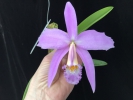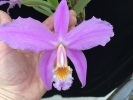|
|
|
|
|
| |
Flasks of
Cattleya jongheana 'Assendorfer C' × 'Assendorfer D' |
|
| |
|
|
| |
| Number: |
TN8582 |
| Name: |
Cattleya jongheana 'Assendorfer C' × 'Assendorfer D'
|
| Type: |
outcross (What's that?) |
|
Seed Donor: |
Ms Cynthia Hill
|
|
Click to Enlarge

Pod Parent Flower |
Click to Enlarge

Pollen Parent Flower |
|
|
|
| |
For additional origin/habitat information supplied courtesy of
Charles and Margaret Baker, see further below, near the bottom of this page.
|
Temperatures we attempt to use in the lab & greenhouse:
| For Species: |
|
Spring, Summer, Autumn, : days average 87°F, nights 64°F; best fit is Warm-Intermediate 87-64°F
(Source:
C. Hill pers comm) |
| For Species: |
|
Winter, : days average 75°F, nights 58°F; best fit is Cool-Intermediate 75-58°F
(Source:
C. Hill pers comm) |
| For Genus: |
|
Spring, Summer, Autumn, Winter: days average 83°F, nights 60°F; best fit is Intermediate 83-60°F
(
) |
|
About the name...
| Etymology of |
Cattleya |
|
Named in honor of William Cattley, English horticulturist in the 19th century.
(Source:
Pridgeon 1992) |
| Etymology of |
jongheana |
|
Named for de Jonge, Belgian orchid nursery of the 19th century.
(Source:
Mayr & Schmucker 1998) |
| Pronunciation of |
Cattleya |
|
KAT-lee-ya
(Sources:
Pridgeon 1992, Hawkes 1978) |
| Pronunciation of |
jongheana |
|
zhong-ee-AH-na
(Source:
Hawkes 1978) |
|
If you would like to direct someone to this web page, please copy and paste this URL into your email:
http://troymeyers.com/d?018582
| Flask Information |
| Availability: |
We have sold all of the flasks for this item. |
| You should: |
Consider getting individual plants or compots instead of a flask.
You can place a "Notify Flask Recipients" Request, and either we or a flask recipient may contact you when plants are available.
You may also place a "Notify Retries" Request, and if an identical pollination (the same parents) is done again, we'll let you know.
You may reserve a flask, but it's very unlikely you'll get one ...this could only happen if we found a flask that we didn't know we had. |
| Yield Estimate: |
300 plants (based on flask surveys done 07/31/2019 through 03/09/2020)
|
| Plantlet Sizes: |
From many flasks 30 - 80 mm plants (based on flask surveys done 03/09/2020 through 05/31/2020)
From one most recently surveyed flask 60 - 80 mm (05/31/2020)
|
|
You might also want to:
|
View the seed assay for this item.
View items of the same species.
View items of the same genus.
|
| Ordering Information |
| You are not currently logged in. |
|
You must be a registered user and be logged in to reserve a flask or place a notification request. Please log in:
|
|
|
|
|
|
| |
The origin/habitat information below is supplied courtesy of Charles and Margaret Baker
The following information is based on the name of the plant provided by the donor, and assumes that the name is correct. If the plant has been misidentified, then the following information may not be correct.
This text is copyrighted by the Bakers and may not be reproduced without permission.
ORIGIN/HABITAT: Brazil. This very rare species is found on the eastern
slopes of Pico do Itambé in the central part of Minas Gerais at 4250–5250
ft. (1300–1600 m). Plants are attached to trees that grow in the bottom of
steep-sided rocky gulches. Even during the dry season, these gullies
normally have at least a trickle of flowing water.
More about this information and the Bakers...
|
|
|
| |
|
|
|